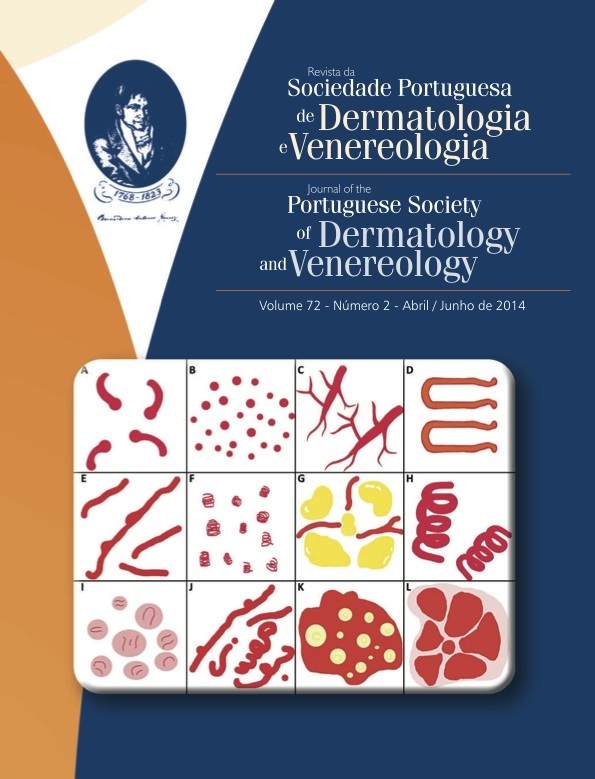PROZONE PHENOMENON IN HIV NEGATIVE PATIENT
Abstract
Prozone phenomenon results from high antibody titers in patients with syphilis, causing a false negative Venereal Disease Research Laboratory (VDRL) results. We report a case of a 50-year-old female patient, with a chief complaint of diffuse, erythematous and asymptomatic lesions, conjunctival hyperemia in her left eye. The physical examination: maculopapular rash on the trunk, back, abdomen and face and right epitrochlear adenopathy. She brought general tests within normal limits and negative VDRL. We requested FTA-ABS IgG:+ and VDRL in diluted serum: 1:512. The optimal ratio of the antigen/antibody yields an insoluble precipitate that is visible, thus rendering the test positive. Thus, phenomenon prozon was confirmed.
Downloads
References
Sidana R, Mangala HC, Murugesh SB, Ravindra K. Prozone phenomenon in secondary syphilis. Indian J Sex Transm Dis 2011; 32:47-9.
Singh AE, Romanowski B. Syphilis: review with emphasis on clinical, epidemiologic and some biologic features. Clin Microbiol Rev. 1999; 12:187-209.
Codes JS, Cohen DA, Melo NA, Teixeira GG, Leal Ados S, Silva Tde J, et al. Screening of sexually transmitted
diseases in clinical and non-clinical settings in Salvador, Bahia, Brazil. Cad Saude Publica. 2006; 22:325-34.
Azevedo LKA; Fernandes PSG; Silva DGKC; Neto MJB; Queiroz MGL; Dantas VCR et al. Caracterização e correlação do fenômeno pró-zona com títulos de sororeatividade do VDRL e reação de imunofluorescência indireta em soros de pacientes com sífilis RBAC. 2006; 38(3): 183-7.
Azulay RD, Azulay DR. Dermatologia. 5ed. Rio de Janeiro: Guanabara Koogan; 2008.
Wuepper KD, Tuffanelli DL. False positive reaction to VDRL test with prozone phenomena.Association of lymphosarcoma. JAMA. 1966; 195:868-9.
Avelleira JC, Bottino G. Sífilis: diagnóstico, tratamento e controle. An Bras Dermatol. 2006; 81(2) :111-26.
Larsen SA, Steiner BM, Rudolph AH. Laboratory diagnosis and interpretation of tests for syphilis. Clin Microbiol Rev. 1995; 8:1-21.
Rompalo AM, Cannon RO, Quinn TC, Hook EW. Association of biologic false-positive reactions for syphilis with human immunodeficiency virus infection. J Infect Dis. 1992; 165:1124-6.
Musher DM, Hamill RJ, Baughn RE. Effect of human immunodeficiency virus (HIV) infection on the course of syphilis and on the response to treatment. Ann Intern Med. 1990; 113:872-81.
Johnson PD, Graves SR, Stewart L, Warren R, Dwyer B, Lucas CR. Specific syphilis serological test may become negative in HIV infection. AIDS. 1991; 5:419-23.
Nayak S, Acharjya B. VDRL Test and its Interpretation. Indian J Dermatol. 2012; 57(1):3-8.
Brasil. Ministério da Saúde. Manual de Controle das Doenças Sexualmente Transmissíveis. 3ed. Brasília: Ministério da Saúde; 1999.
Erbelding EJ, Vlahov D, Nelson KE, Rompalo AM, Cohn S, Sanchez P, et al. Syphilis serology in human immunodeficiency virus infection: Evidence for false-negative fluorescent treponemal testing. J Infect Dis. 1997; 176:1397-400.
Augenbraun MH, DeHovitz JA, Feldman J, Clarke L, Landesman S, Minkoff HM. Biological false-positive
syphilis test results for women infected with human immunodeficiency virus. Clin Infect Dis. 1994; 19:1040-4.
Sampaio SAP; Rivitti EA. Dermatologia. 3ª ed. São Paulo: Artes Médicas; 2007.
Lane HC, Masur H, Edgar LC, Whalen G, Rook AH, Fauci AS. Abnormalities of cell activation and immunoregulation in patients with the acquired immunodeficiency syndrome. N Engl J Med. 1983; 309:453-8.
Malone JL, Wallace MR, Hendrick BB, LaRocco A, Jr, Tonon E, Brodine SK, et al. Syphilis and neurosyphilis
in a human immunodeficiency virus type-1 seropositive population: Evidence for frequent serologic relapse after therapy. Am J Med. 1995; 99:55-63.
All articles in this journal are Open Access under the Creative Commons Attribution-NonCommercial 4.0 International License (CC BY-NC 4.0).








